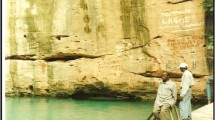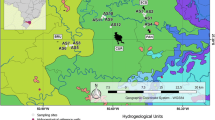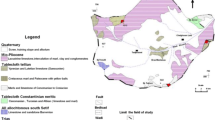Abstract
Seymareh Dam on Seymareh River is one of the highest concrete dams in Iran. The dam reservoir lies on Quaternary deposits, Gachsaran and Asmari formations. About 60 springs were identified downstream of the dam before impounding the reservoir. The springs increased up to more than 200 in number following impounding the reservoir up to elevation (El.) 704.5 m above sea level (masl). Before impounding the reservoir, total discharge of springs was about 2m3/sec., and after impounding up to El. 704.5 masl, it raised up to 8–10 m3/sec. The variation in reservoir level directly affects the water quality of some springs. Geological and engineering geological conditions of the dam site along with the physico-chemical analysis of the water samples including measurement of common anions and cations, electrical conductivity (EC) and total dissolved solids (TDS) were evaluated during this study. Review of physico-chemical analysis showed that the most changes are related to the increase in Cl−, Na+ and Ca++ ions after reservoir impounding up to El. 704.5 masl. Different assumptions were introduced to determine the causes for groundwater quality changes. After evaluating these assumptions, the combination of factors such as mixing seepage water with saline water in the deep part of the calcareous aquifer having the source of formational dissolution and oil brine was identified as factors decreasing the groundwater quality of the downstream springs.

















Similar content being viewed by others
References
Alcala FJ, Custodio E (2008) Using the Cl/Br ratio as a tracer to identify the origin of salinity in aquifers in Spain and Portugal. J Hydrol 359(1–2):189–207. https://doi.org/10.1016/j.jhydrol.2008.06.028
Ansari MA, Deodhar A, Kumar SU, Khatti SV (2015) Water quality of few springs in outer Himalayas, A study on the groundwater–bed rock interactions and hydro-chemical evolution. Groundw Sustain Dev 1(1–2):159–167. https://doi.org/10.1016/j.gsd.2016.01.002
Atlas RM, Bartha R (1998) Microbial Ecology—Fundamentals and Applications, 4th edn. Addison Wesley Longman Inc., Menlo Park, California
Behrouj Peely A, Mohammadi Z, Raeisi E, Solgi Kh, Mousavi MJ, Kamali M (2018) Hydrogeological characterization of flow system in a karstic aquifer, Seymareh dam. Iran J African Sci 143:266–277. https://doi.org/10.1016/j.jafrearsci.2018.03.025
Brown RH, Parker GG (1945) Salt-water encroachment in limestone at Silver Bluff Miami. Econ Geol 40(4):235–262
Carpenter AB (1978) Origin and chemical evolution of brines in sedimentary basins. In: SPE Annual Fall Technical Conference and Exhibition. Soc Petrol Eng
Carreira PM, Marques JM, Nunes D (2014) Source of groundwater salinity in coastline aquifers based on environmental isotopes (Portugal): Natural vs. human interference. A Review and Reinterpretation Applied Geochemistry 41:163–175. https://doi.org/10.1016/j.apgeochem.2013.12.012
Cheshomi A, Sahbaniya Y, Ashjari J (2014) Assessment of water seepage through the right abutment of the Seymareh dam. Geopersia 4(2):213–225. https://doi.org/10.22059/JGEOPE.2014.52720
Clayton RN, Friedman I, Graf DL, Mayeda WK, Meents WF, Shimp NF (1966) The origin of saline formation waters, isotopic composition. L. Geophys Res 71:3869–3882
Craft D (2005) Seepage chemistry manual, Report DSO-05–03. United States Bureau of Reclamation (USBR)
Eastoe CJ, Long A, Knauth LP (1999) Stable chlorine isotopes in the Palo Duro Basin, Texas: evidence for preservation of Permian evaporite brines. Geochim Cosmochim Acta 63(9):1375–1382. https://doi.org/10.1016/S0016-7037(99)00186-6
Eggenkamp HGM, Kreulen R, Koster Van Groof AF, (1995) Chlorine stable isotop fractionation in evaporates. 382 Geochimica rt Cosmochimica Acta 59(24):5169–5175
Fetter CW (1999) Contaminant hydrogeology. 2d ed., Prentice Hall Inc., NJ. p 506
Hocini N, Moulla AS (2005) Detection of water leaks in foum El-Gherza dam (Algeria), Ninth International Water Technology Conference, IWTC9, Sharm El-Sheikh, Egypt
Holser WT (1979) Trace elements and isotopes in evaporites. In: Marine Minerals, Vol. 6. Mineralogical Society of America Short Course Notes, pp 295–346
Hounslow A (1995) Water quality data- Analysis and interpretation. ISBN 978087371676, CRC press, 416
Hubbert MK (1940) The theory of ground-water motion. J Geol 48(8):785–944
Jalali L, Zarei M, Gutierrez F (2019) Salinization of reservoirs in regions with exposed evaporites. The Unique Case of Upper Gotvand Dam, Iran, Water Research 157:587–599. https://doi.org/10.1016/j.watres.2019.04.015
Kang A, Jackson RB (2016) Salinity of deep groundwater in California: Water quantity, quality, and protection. Proceedings National Academy Sciences U S a 113(28):7768–7773
Lucey KJ (1991) Analysis of the ground-water flow system geochemistry, and underseepage in the vicinity of the Red Rock Dam near Pella, Iowa, U.S. Army Corps of engineering- Water resources investigations report 91–4092
Mahab Ghodss Consulting Engineers (2011) Reservoir impounding studies of Seymareh dam and hydro power project - Presentation and evaluation of grout curtain behavior results during the first impounding (1st Report)
Mahab Ghodss Consulting Engineers (2008) Complementary studies of grout curtain of Seymareh dam and hydro power project – Grout curtain design review report
Mahab Ghodss Consulting Engineers (2009) Complementary studies of grout curtain of Seymareh dam and hydro power project – Left bank seepage Analysis updating report
Mahab Ghodss Consulting Engineers (1999) Seymareh dam and hydro power project phase I studies – Engineering geological report
Mahab Ghodss Consulting Engineers (2001) Seymareh dam and hydro power project phase II studies – Engineering geological report and maps
Mehdizadeh R, Zarei M, Raeisi E (2015) How subaerial salt extrusions influence water quality in adjacent aquifers. J Hydrol 531(3):1108–1113. https://doi.org/10.1016/j.jhydrol.2015.11.021
Mohallel SA, Abdella FH, Habibah ZA (2019) Hydrogeochemical assessment of groundwater quality at Wadi Abbadi, southern part of eastern desert, Egypt. Curr Sci Int. ISSN: 2077–4435, 08(2):422–438
Najmi AA (2012) Comparison of three-dimensional and two-dimensional analysis of seepage in complex geological conditions-Case study of Seymareh Dam, Thesis for receiving a master's degree in Geotechnical Engineering, University of Tehran (In Persian)
National Iranian Oil Company (1970) Kabir Kuh geological map, sheet W 29237. Scale 1:100.000
Noble J, Ansari AM (2017) Environmental isotope investigation for the identification of source of springs observed in the hillock on the left flank of Gollaleru Earthen Dam, Andhra Pradesh, India. J Earth Syst Sci 126(5):article id.67, 12 pp. https://doi.org/10.1007/s12040-017-0843-x
Piper AM (1994) A graphic procedure in the geochemical interpretation of water analyses: American Geophysical Union. Transactions 25:914–923
Richter BC Kreitler W (1993) Geochemical techniques for identifying sources of ground-water salinization, report of investigation No. 191, Bureau of Economic Geology
Rittenhouse G (1967) Bromine in oil-field waters and its use in determining possibilities of origin of these waters. AAPG Bull 51(12):2430–2440. https://doi.org/10.1306/5D25C27D-16C1-11D7-8645000102C1865D
Sahbania Y, Ashjari J, Cheshmi A, Solgi Kh (2012) Investigation of the hydraulic relationship of the reservoir and downstream on the right bank of Seymareh Dam, 16th Conference of the Iranian Geological Society. Iranian Geological Society, Shiraz University, Shiraz
Taboga KG, Wittke SJ, Stafford J E, Rodgers JR (2016) Groundwater salinity in the Denver-Julesburg Basin, Wyoming, Wyoming State Geological Survey, Open File Report 2016–2
Todd DK, Mays LW (2005) Groundwater hydrology, John Wiley and Sons. Pp, New York, p 535
Winslow AG, Doyel WW, Wood LA (1957) Salt water and its relation to fresh ground water in Harris County, Texas, Geological Sorvey Water –Supply Paper 1360-F. Prepared in cooperation with Texas Board of Water Engineering and the city of Houston
Zarei M (2016) Factors governing the impact of emerged salt diapirs on water resources. Ground Water 54(3):354–362. https://doi.org/10.1111/gwat.12370
Acknowledgements
We thank Mahab Ghodss Consulting Engineering Co. (the project Consultant) and IWPCO (the project Client) as supporters of this research and all other parties involved.
Author information
Authors and Affiliations
Corresponding author
Ethics declarations
Conflict of interest
The authors declare no competing interests.
Rights and permissions
Springer Nature or its licensor holds exclusive rights to this article under a publishing agreement with the author(s) or other rightsholder(s); author self-archiving of the accepted manuscript version of this article is solely governed by the terms of such publishing agreement and applicable law.
About this article
Cite this article
Cheshomi, A., Solgi, K., Milanovic, P. et al. Study on factors affecting the groundwater and springs quality downstream of Seymareh Dam—Iran. Bull Eng Geol Environ 81, 444 (2022). https://doi.org/10.1007/s10064-022-02877-8
Received:
Accepted:
Published:
DOI: https://doi.org/10.1007/s10064-022-02877-8




